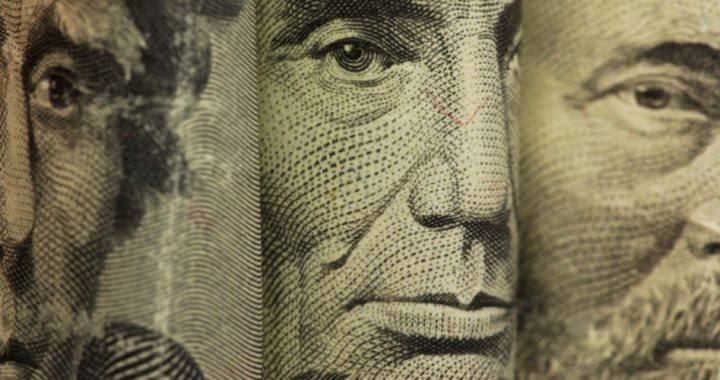
According to the latest report from the Congressional Budget Office (CBO), released on Monday, the U.S. economy is going great guns. But that growth, no matter how robust, will never catch up with government spending. Hence, despite that growth, annual deficits of a trillion dollars will arrive two years sooner than originally projected.
That previous projection, made by the CBO last June, showed a deficit of $563 billion for 2018, rising to $689 billion next year. Now, with the Tax Cuts and Jobs Act behind them, the CBO projects this year’s deficit to be $804 billion and next year’s to be just a touch below a trillion dollars, at $981 billion.
The CBO is considered by many to be less partisan than most government entities and as likely to create more accurate projections than those coming from the White House’s Office of Management and Budget (OMB). It covered itself with this disclaimer:
CBO’s projections, especially its economic projections, are even more uncertain this year, because they incorporate estimates of the economic effects of the recent changes in fiscal policy [the tax reform bill] — and those estimates are themselves uncertain.
Translation: We’re essentially clueless as to the impact Trump’s tax reform law will have in the future, and so “we formulate projections that fill in the middle … of possible outcomes.”
One outcome is certain: Government spending is running away from government revenues, with no relief in sight. Consider: The federal government is slated to spend $4.1 trillion this year, with $2.5 trillion (61 percent) on entitlements (i.e., Social Security, Medicare, and other “transfer” payments). In 10 years, according to the CBO, the government will be spending $7 trillion a year, with $4.5 trillion of that on entitlements (64 percent). Put another way: Entitlements will grow from $2.5 trillion today to $4.5 trillion in 10 years. That’s a jump of 80 percent.
And interest payments, which are expected to total $241 billion in fiscal year 2018, will leap, according to the CBO, to nearly a trillion dollars annually in 10 years.
These numbers are so incomprehensibly large that it’s useful to consider a small business owner seeking to grow his business to provide better for his family. He decides to take out a HELOC (home equity line of credit) and uses the proceeds to expand his workplace, hire more workers, pay for tuition for himself and his employees at a local community college, and expand his advertising. His projections all make sense: He anticipates that his profitability will grow by more than enough not only to cover the interest expense on his HELOC but to pay it off entirely in 10 years.
But within the first year, he realizes that that profitability projection is not only too generous, it is far out of reach. He now starts using his credit cards to service his HELOC. One can draw the inevitable conclusion: He is headed for bankruptcy.
However, to take this example further, our erstwhile business owner hears Dave Ramsay on the radio, enlists in his video program called Financial Peace University, and begins to do what the federal government is unable or unwilling to do: cut expenses. He sells one of his cars and trades in the other one for a beater. He negotiates a better deal on his office lease. He and his wife learn to shop with coupons and do without credit cards (they have burned them at a celebration party). They eat out once a month instead of two or three times a week. They buy in bulk at Sam’s Club. He takes on part-time work with a local construction company.
Within a few years, our business owner is debt-free, sleeps better at night, and rejoices in his financial freedom.
Could this apply to the federal government as well? What is the government’s fabled “elephant in the living room?” Entitlements. Estimates about the shortfalls between promises made to Social Security recipients and the agency’s ability to keep the promises range from $35 billion to $200 billion. Fast forward to 2021: The presidential election is now over, and Congress is back to business. Now, however, the landscape has changed. Investors are demanding higher interest rates to cover the risk of default that has escalated sharply in the last couple of years. Congress has run out of road. Some of those promises will be broken.
Congress has one advantage that our business owner doesn’t: the Federal Reserve System. When the economy imploded back in 2008-2009 and banks got in trouble, the Fed bailed them out with trillions of taxpayer dollars. However, even that avenue is paved with uncertainty. At present the Fed’s balance sheet exceeds $4 trillion, thanks to those bailouts from a decade ago. Just how much larger can it grow in the face of the next crisis?
This is the iron rule of finance: Every debt gets paid, somehow. This is the obverse of the law: There is no such thing as an eternal free lunch. As the CBO so eloquently concluded its summary: “Federal debt is projected to be on a steadily rising trajectory throughout the coming decade … [while] after 2019 economic growth is projected to slow.”
Image: Clipart.com
An Ivy League graduate and former investment advisor, Bob is a regular contributor to The New American magazine and blogs frequently at LightFromTheRight.com, primarily on economics and politics. He can be reached at [email protected].



